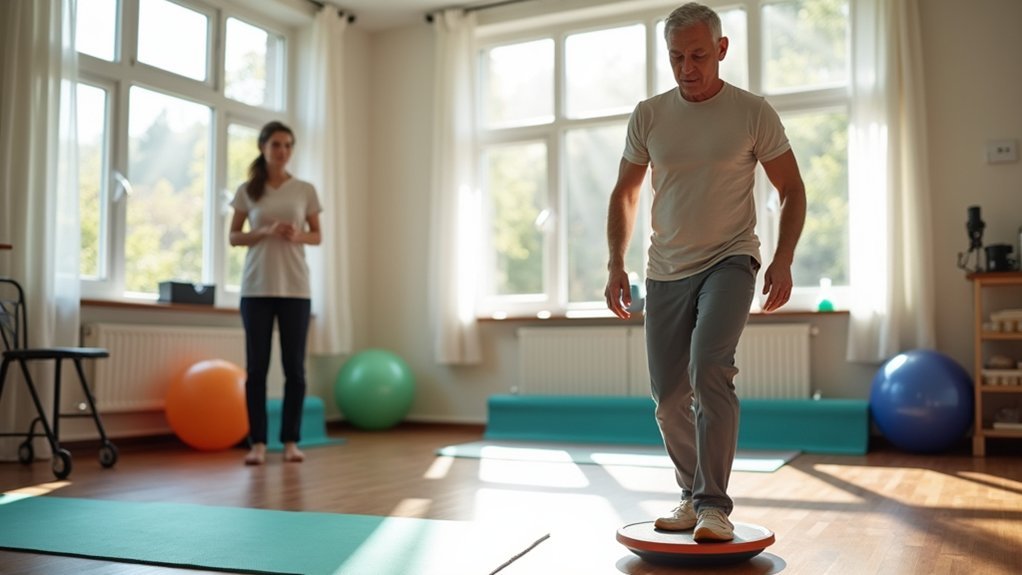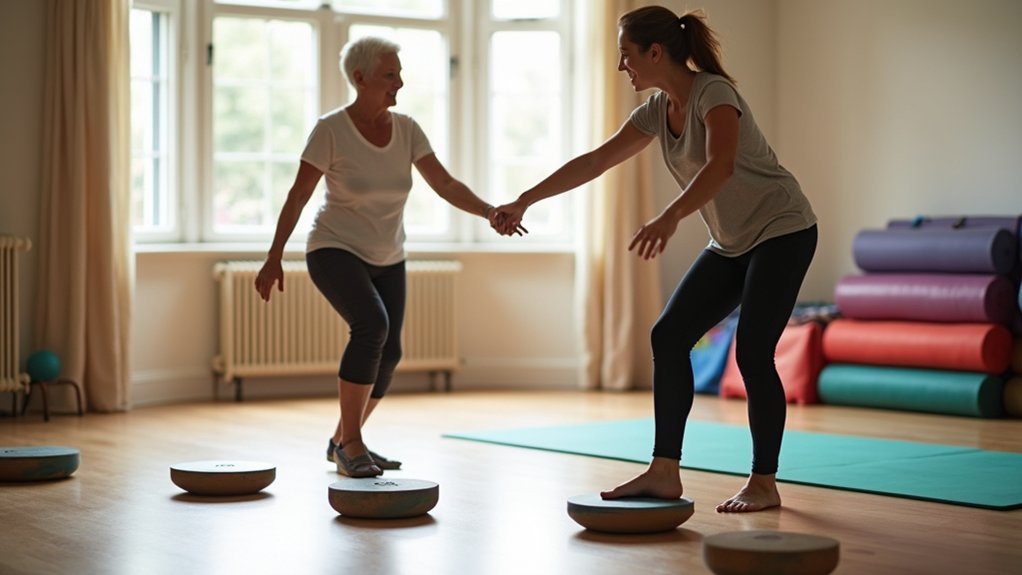Balance tools for Parkinson’s disease specifically target core stability and proprioception that deteriorate with the condition. You’ll strengthen muscles critical for preventing falls while improving your posture and coordination. These tools create unstable surfaces that challenge and train your balance systems, helping you respond better to everyday movements. Regular practice builds confidence and independence in daily activities. Clinical studies show these interventions greatly reduce fall risk and enhance your mobility—discover how these simple tools can transform your Parkinson’s journey.
The Critical Role of Balance in Parkinson’s Management

When managing Parkinson’s disease, balance training stands as a cornerstone of effective treatment.
Your ability to maintain stability directly impacts your safety and independence in daily living activities.
Falls represent one of the most significant risks for individuals with Parkinson’s disease, often leading to serious injuries that can compromise your quality of life.
Types of Balance Tools That Benefit Parkinson’s Patients
You’ll find balance boards exceptionally effective for strengthening your core muscles, which serve as your body’s stability center when living with Parkinson’s.
Wobble cushions provide an unpredictable surface that challenges and enhances your balance reactions during both seated and standing exercises.
Resistance bands complement these tools by improving your coordination while simultaneously building strength in key muscle groups that support balanced movement.
Balance Boards Strengthen Core
The humble balance board offers a powerful approach to improving stability for Parkinson’s patients. When you stand on these uneven surfaces, you’re actually simulating real-life scenarios that challenge and strengthen your core muscles—essential components for maintaining balance with Parkinson’s disease.
You’ll notice that balance boards not only build core strength but also enhance your postural awareness, directly reducing your fall risk. Research confirms that these tools greatly improve balance components during rehabilitation exercises.
Don’t worry about safety—most balance boards feature non-slip surfaces that let you focus on the exercise without excessive fear of falling.
Their interactive nature makes training enjoyable, helping you overcome initial hesitation while strengthening your core. This increased motivation translates into consistent practice and improved physical abilities.
Wobble Cushions Enhance Stability
Wobble cushions offer another dimension to balance training for Parkinson’s patients beyond traditional balance boards.
These inflatable tools create an unstable surface that challenges your body’s equilibrium, forcing your core muscles to engage while improving proprioception. You’ll notice significant improvements in your overall stability as you incorporate these versatile tools into your exercise routine.
- Reduce your fall risk through regular practice on the uneven surface, which enhances balance control specifically affected by Parkinson’s disease.
- Easily integrate wobble cushions into daily activities and exercises to improve functional movement.
- Build confidence in your mobility as you master balancing on these cushions, encouraging more active participation in physical activities.
Using wobble cushions consistently provides an effective, accessible way to enhance stability while living with Parkinson’s disease.
Resistance Bands Improve Coordination
Resistance bands serve as powerful tools for individuals with Parkinson’s disease, offering a versatile approach to improving coordination while simultaneously building essential muscle strength.
When you incorporate these bands into your balance training, you’ll enhance your proprioception—your body’s awareness of position and movement. This improvement directly translates to better coordination and stability in daily activities. Research confirms that resistance training greatly enhances mobility among those with Parkinson’s disease.
You’ll find that resistance bands strengthen your core muscles, vital for maintaining stability and reducing fall risks. Their portability means you can practice coordination exercises anywhere—whether at physical therapy sessions or in your living room.
The adjustable resistance levels allow you to progressively challenge yourself as your strength improves, making them ideal for long-term management of Parkinson’s symptoms.
How Balance Boards Strengthen Core Stability
While many rehabilitation tools focus solely on specific muscle groups, balance boards create a thorough workout environment that actively engages your core muscles through constant micro-adjustments.
For those with Parkinson’s disease, these unstable platforms challenge your body to maintain position, strengthening abdominal and back muscles essential for posture and movement.
You’ll notice improved proprioception and body awareness as you practice, leading to better coordination in daily activities.
Balance boards effectively reduce fall risk by training your body to respond quickly to shifts in weight and position.
- Build confidence as you master increasingly difficult balance challenges
- Enhance functional mobility through regular core-strengthening sessions
- Develop resilience in managing Parkinson’s symptoms through progressive balance training
Building Confidence Through Progressive Balance Challenges

You’ll gradually conquer balance challenges by starting with simple exercises and slowly advancing to more complex ones, transforming initial fear into empowering achievements.
Celebrating each improvement, no matter how small, reinforces your progress and motivates continued practice with balance tools.
Your journey from hesitation to confidence happens through consistent practice, supportive community engagement, and recognizing the remarkable improvements in your stability and overall quality of life.
Incremental Difficulty Progression
As individuals with Parkinson’s disease navigate their balance challenges, starting small and gradually increasing difficulty creates a foundation for success.
Progressive balance challenges strengthen your core muscles and improve overall stability—crucial elements for maintaining mobility and preventing falls. You’ll gain confidence as you master each level, reducing the fear that often limits activity.
- Begin with simple balance training exercises on stable surfaces before advancing to balance boards that simulate real-life scenarios.
- Track your progress through different difficulty levels to celebrate improvements and maintain motivation.
- Join group sessions where the supportive community encourages you to push beyond comfort zones safely.
This incremental approach not only builds physical capability but also fosters the resilience needed to tackle daily mobility challenges with greater assurance.
Celebrating Small Victories
Success stories begin with small steps on the path to better balance. When you successfully navigate uneven surfaces using balance boards, you’re gaining real-life skills that translate directly to daily activities. Each small victory builds body awareness and improves posture—essential components for maintaining stability.
Celebrating small successes creates a supportive environment where you can push beyond initial fears. As you master progressive balance challenges, you’ll notice increased confidence and greater independence. The “Rocksteady family” atmosphere in classes reinforces your motivation and resilience, making it easier to confront difficult balance exercises.
Consistent practice strengthens your core muscles while simultaneously building confidence. This powerful combination reduces fall risk and enhances your quality of life, proving that even the smallest improvements deserve recognition on your Parkinson’s journey.
Fear-to-Freedom Journey
The journey from fear to freedom with Parkinson’s begins on unstable ground—literally. As you practice with balance tools, you’ll gradually build confidence while strengthening core muscles that improve stability.
It’s important to work through progressive challenges that simulate real-life surfaces, reducing your fall risk while increasing independence.
- Balance boards and other tools create activities that bring immediate feedback about your center of gravity
- Each small achievement in your balance practice creates momentum toward greater mobility
- Sharing challenges with your “Rocksteady family” provides motivation when facing difficult exercises
The supportive environment of balance classes transforms initial doubt into capability. Many participants exceed their own expectations, discovering freedom in movement they once thought impossible.
Your balance journey isn’t just about preventing falls—it’s about reclaiming confidence.
Integrating Balance Tools Into Daily Routines

While managing Parkinson’s symptoms requires thorough care, incorporating balance tools into your everyday activities can greatly enhance stability and confidence.
You’ll find that consistent use of tools like balance boards strengthens your core and improves posture, directly reducing your fall risk.
Try integrating these tools during regular activities to simulate real-life challenges you might encounter. This practical approach helps you develop the skills needed when maneuvering uneven surfaces in your environment.
What’s particularly encouraging is that regular practice with balance tools produces measurable improvements in control and stability.
You’re not alone in this journey—many find that using these tools in group settings creates valuable community support, boosting motivation as you share progress with others facing similar challenges.
Research-Backed Benefits of Balance Training
Scientific research consistently validates the effectiveness of balance training for Parkinson’s disease patients, with evidence spanning numerous clinical studies. A thorough review of 114 studies involving over 5,300 participants demonstrates that multi-modal interventions targeting nearly six balance components markedly improve stability and reduce fall risks.
- Sensory-motor interventions enhance balance control by integrating various sensory inputs, effectively addressing the neurological challenges you face with Parkinson’s.
- Exergaming approaches maintain high engagement while monitoring training intensity—a vital factor for successful balance outcomes.
- Balance tools like balance boards strengthen your core muscles and improve posture, leading to greater confidence and improved quality of life through enhanced functional independence.
These evidence-based approaches offer concrete strategies to improve your mobility and daily functioning despite Parkinson’s challenges.
Creating a Safe Environment for Balance Practice
Because falls present a considerable risk for Parkinson’s patients, establishing a safe practice environment forms the foundation of effective balance training.
You’ll want to create a designated practice area that’s clear of furniture, cords, and other obstacles that could cause trips.
Invest in non-slip surfaces like rubber mats or non-skid floor coverings to provide stable footing during your exercises.
These surfaces considerably reduce the risk of slipping while allowing you to focus on the movements themselves.
Install safety aids such as handrails or stable chairs that you can hold for support when needed.
Place cushioned mats nearby as a precaution.
Remember to regularly reassess your practice space as your needs change, making adjustments that enhance both safety and confidence while you work on improving your balance.
Frequently Asked Questions
Do Balance Exercises Help With Parkinson’s?
Yes, balance exercises help with Parkinson’s. They’ll reduce your fall risk, strengthen your core, improve your stability, and enhance your quality of life by promoting functional independence and daily confidence.
Why Is Balance Affected in Parkinson’s Disease?
Your balance is affected in Parkinson’s disease because dopamine-producing neurons degenerate, impairing your basal ganglia’s function. This causes muscle rigidity, slowed movements, and cognitive processing delays that disrupt your stability and coordination.
What Is the Balance Assessment for Parkinson’s Disease?
Balance assessments for Parkinson’s disease include the Berg Balance Scale and Timed Up and Go test. You’ll perform tasks like standing up, walking short distances, and turning around while clinicians measure your stability and fall risk.
What Tools Help With Parkinson’s Disease?
Tools that help with Parkinson’s disease include balance boards, rollator walkers, canes, exergaming systems, adaptive computer mice, and speech aids. You’ll benefit most when these are customized by occupational or physical therapists.
In Summary
Balance tools aren’t just equipment—they’re your pathway to greater independence with Parkinson’s disease. You’ll reduce fall risk, strengthen core muscles, and build confidence as you practice. By incorporating these tools into your daily routine, you’re actively fighting against disease progression. Remember, consistent balance training yields measurable improvements, so start small and progress gradually within your safe, supportive environment.





Leave a Reply